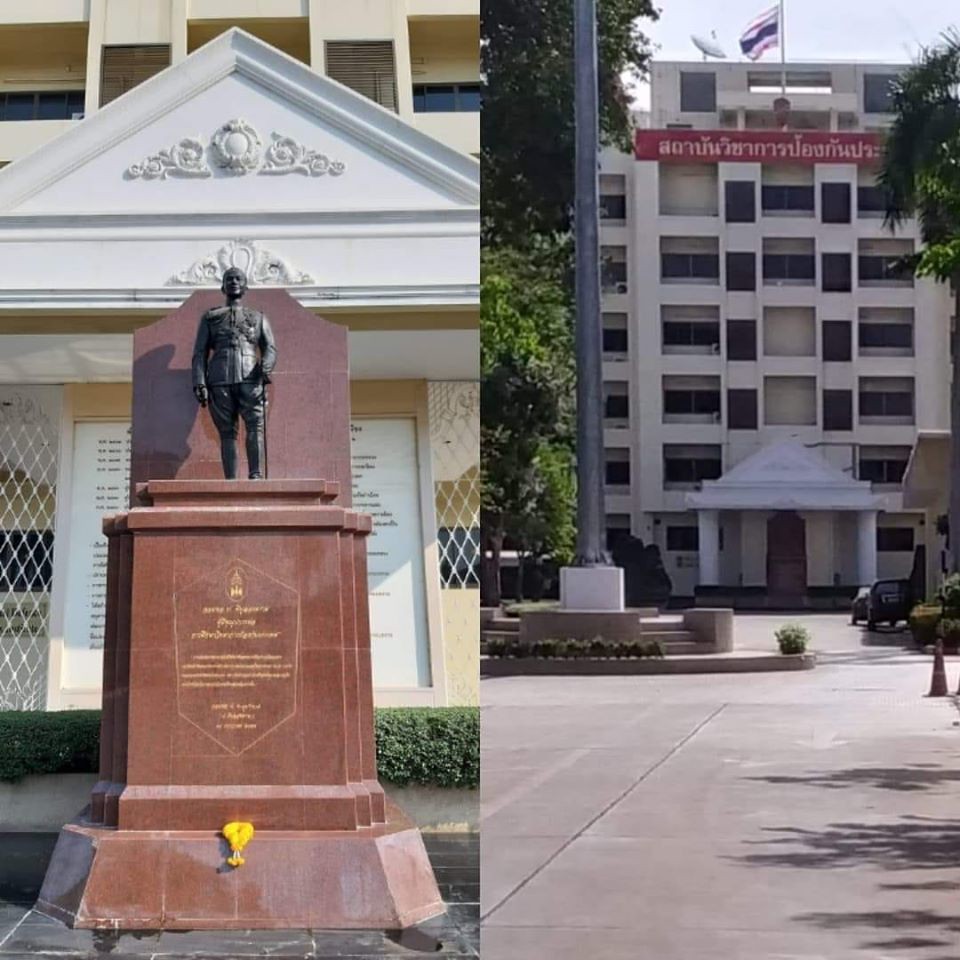Statues dedicated to Field Marshal Plaek Phibunsongkhram and Phraya Phahonphonphayuhasena, military officers and leading members of the 1932 revolution which ended Thailand’s absolute monarchy, have gone missing as of last Sunday (26 January).

The former site of the Phraya Phahonphonpayuhasena statue at the Fort Phaholyothin Artillery Centre
Prachatai travelled to the Fort Phaholyothin Artillery Centre in Lopburi on Sunday and found that the statue of revolutionary leader and former prime minister Phraya Phahonphonphayuhasena, which stood in front of the officers’ club building, has gone missing. According to an officer at the Artillery Centre, the statue was removed last week.
Born Phot Phahonyothin, Phraya Phahon was a military officer and leader of the People’s Party, the group behind the revolution of 1932, the revolution which ended the absolute monarchy in Thailand and marked the beginning of democracy. He also served as Thailand’s prime minister from 1933 to 1938.
Phaholyothin Road, one of Bangkok’s main roads running through the city and continuing through the country to end at the Thai-Myanmar border in Mae Sai, was named in his honour.

Above: Officers and graduates of the Artillery School take a group photo in front of the Phraya Phahon statue
Below: The location where the photo was taken as of 26 January
Last December, BBC Thai, citing Phraya Phahon’s son Phuttinat, reported that the Artillery Centre would be holding a ceremony to pay respect to the statue before moving it. The Centre later announced that the ceremony had been postponed, and it is currently unclear when the statue was moved and where it has been moved to.
Khaosod English also reported that the name “Fort Phaholyothin” has been removed from the gate of the Artillery Centre.
Another statue depicting Field Marshal Plaek Phibunsongkhram, also a member of the military wing of the People’s Party and Thailand’s longest serving Prime Minister to date, has gone missing from the National Defence College of Thailand (NDC).

Left: the Plaek Phibunsongkhram statue at the National Defence College
Right: A picture taken on 26 January at the NDC showing the empty platform on which the statue used to stand
Commonly known as Phibun, the Field Marshal was one of the military commanders who suppressed the 1933 royalist revolt known as the Boworadet Rebellion. He was elected Prime Minister after Phraya Phahon’s resignation and was responsible for a modernization campaign, which included a series of cultural mandates aiming to ‘civilize’ Thai culture as well as declaring the change of the country’s name from “Siam” to “Thailand.” He also promoted Thai nationalism, Sinophobia, and allied the country with Japan during the Second World War. His first term in office lasted from 1938 to 1944.
He returned to power after a coup in 1947. During his second term, Phibun aligned Thailand with anti-communism in the Cold War, entered the Korean War, and attempted to transform Thailand into a liberal democracy. He was overthrown in 1957 and went into exile in Japan. To date, he is the longest serving Prime Minister of Thailand.
Prachatai went to the NDC twice, first on 23 January after a rumour emerged that the statue was removed and found that it still stood, and again on 26 January, when we found that the statue was now missing.
An NDC security guard insisted that the statue was removed to be restored while the space is being renovated and will be returned once the renovation is completed. However, the security guard refused to disclose information on when the statue was removed.
Monuments dedicated to the 1932 revolution and other legacies of the People’s Party have been the targets in a ‘memory war’ aiming to erase the commemoration of the People’s Party, a process which art historian Chatri Prakitnonthakan says has been going on for decades. Thanavi Chotpradit, another art historian, suggests that there have been attempts to destroy the reputation of the People’s Party and its cultural legacy since the collapse of the government after the coup d’état of 1947.
Since the 2006 coup, this ‘memory war’ has become more intense, and several legacies of the People’s Party have already been destroyed, including the old Supreme Court complex, the People’s Party Plaque, and the Constitution Defence Monument at Laksi. Until now, there is still no information on where the plaque and the Constitution Defence Monument have disappeared to.
Prachatai English is an independent, non-profit news outlet committed to covering underreported issues in Thailand, especially about democratization and human rights, despite pressure from the authorities. Your support will ensure that we stay a professional media source and be able to meet the challenges and deliver in-depth reporting.
• Simple steps to support Prachatai English
1. Bank transfer to account “โครงการหนังสือพิมพ์อินเทอร์เน็ต ประชาไท” or “Prachatai Online Newspaper” 091-0-21689-4, Krungthai Bank
2. Or, Transfer money via Paypal, to e-mail address: [email protected], please leave a comment on the transaction as “For Prachatai English”
